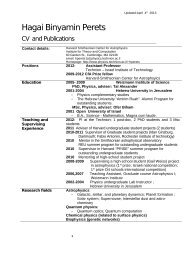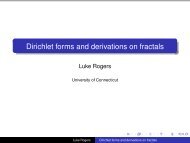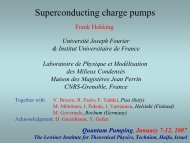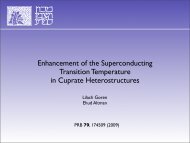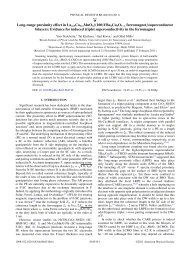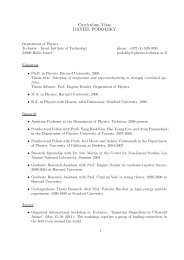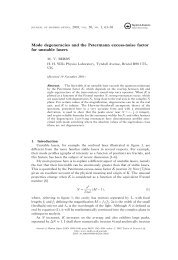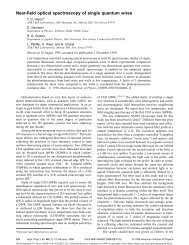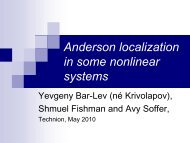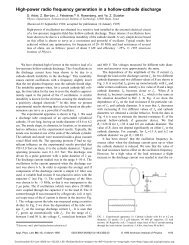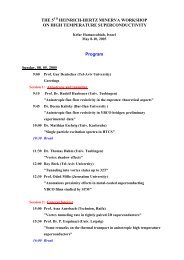Turbulence-degraded wave fronts as fractal surfaces - Physics ...
Turbulence-degraded wave fronts as fractal surfaces - Physics ...
Turbulence-degraded wave fronts as fractal surfaces - Physics ...
Create successful ePaper yourself
Turn your PDF publications into a flip-book with our unique Google optimized e-Paper software.
444 J. Opt. Soc. Am. A/Vol. 11, No. 1/January 1994<br />
<strong>Turbulence</strong>-<strong>degraded</strong> <strong>wave</strong> <strong>fronts</strong> <strong>as</strong> <strong>fractal</strong> <strong>surfaces</strong><br />
C. Schwartz, G. Baum, and E. N. Ribak<br />
Department of <strong>Physics</strong>, Technion-Israel Institute of Technology, Technion City, Haifa 32000, Israel<br />
Received January 7, 1993; revised manuscript received April 29, 1993; accepted June 8, 1993<br />
We identify <strong>wave</strong> <strong>fronts</strong> that have p<strong>as</strong>sed through atmospheric turbulence <strong>as</strong> <strong>fractal</strong> <strong>surfaces</strong> from the Fractional<br />
Brownian motion family. The <strong>fractal</strong> character can be <strong>as</strong>cribed to both the spatial and the temporal behavior.<br />
The simulation of such <strong>wave</strong> <strong>fronts</strong> can be performed with <strong>fractal</strong> algorithms such <strong>as</strong> the Successive Random<br />
Additions algorithm. An important benefit is that <strong>wave</strong> <strong>fronts</strong> can be predicted on the b<strong>as</strong>is of their p<strong>as</strong>t me<strong>as</strong>urements.<br />
A simple temporal prediction reduces by 34% the residual error that is not corrected by adaptiveoptics<br />
systems. Alternatively, it permits a 23% reduction in the me<strong>as</strong>urement bandwidth. Spatiotemporal<br />
prediction that uses neighboring points and the effective wind speed is even more beneficial.<br />
1. INTRODUCTION<br />
We examine the ph<strong>as</strong>e of light that h<strong>as</strong> p<strong>as</strong>sed through<br />
a turbulent atmosphere. The <strong>degraded</strong> <strong>wave</strong> front is a<br />
homogeneous and isotropic stoch<strong>as</strong>tic Gaussian process.'<br />
This process is well described by a structure function that<br />
behaves like a power law over many scales of length in<br />
the so-called inertial range. This range lies between the<br />
inner scale, which is of the order of a few millimeters, and<br />
the outer scale, which is of the order of the height above<br />
the ground. This structure function can be written <strong>as</strong>'<br />
r 5/3<br />
Dq,(r) = ([p(R + r) - p(R)] 2 ) = 6 . 8 8 (f) (1)<br />
\ro/<br />
where r is the well-known Fried length. We obtain this<br />
expression analytically by using the Kolmogorov <strong>as</strong>sumptions<br />
concerning the power spectrum of velocity and temperature<br />
fluctuations in a turbulent medium. The<br />
validity of this function (at le<strong>as</strong>t for the c<strong>as</strong>e of <strong>as</strong>tronomical<br />
imaging) h<strong>as</strong> been demonstrated in many observations.<br />
2 From dimensional re<strong>as</strong>oning it is evident that the<br />
power spectrum of the <strong>wave</strong>-front ph<strong>as</strong>e also h<strong>as</strong> a powerlaw<br />
dependence (which we call the Kolmogorov power spectrum)<br />
on the spatial frequency K:<br />
P,(K) xc . (2)<br />
2. FRACTIONAL-BROWNIAN-MOTION<br />
SURFACES<br />
The relations that are given above resemble a mathematical<br />
entity called Fractional Brownian motion (FBm). 3 ' 4 A<br />
Brownian process B(t) (e.g., in one dimension, the temporal<br />
one) is a Gaussian stoch<strong>as</strong>tic process characterized by<br />
an incremental variance that is proportional to time:<br />
([B(T + t) - B(T)] 2 ) t. (3)<br />
An extension is the FBm, Bh, for which<br />
([Bh(T + t) - Bh(T)] 2 ) C t2H, (4)<br />
where H is the Hurst parameter 4 and is in the range 0-1.<br />
For extension to higher dimensions one changes the<br />
0740-3232/94/010444-08$06.00 © 1994 Optical Society of America<br />
Schwartz et al.<br />
scalars to vectors, and the variance is proportional to the<br />
vector modulus. For H = 0.5 the process is a cl<strong>as</strong>sical<br />
Brownian motion [relation (3)]. Again using dimensional<br />
analysis, we find that the power spectrum of the FBm<br />
w<strong>as</strong> 3 - 5<br />
PB(K) cc-(2H+E) (5)<br />
where E is the standard topological dimension of the generalized<br />
surface. Thus, for a curve, E = 1; for a surface<br />
(such <strong>as</strong> a <strong>wave</strong> front), E = 2, etc. This kind of stoch<strong>as</strong>tic<br />
process is found to describe many natural phenomena<br />
such <strong>as</strong> the discharge of rivers, the Earth's relief, clouds,<br />
and 1/f noise. The generalized surface is a <strong>fractal</strong> in a<br />
self-affine way, i.e., the surface is statistically similar for<br />
all scale lengths, but the dependent variable (in this c<strong>as</strong>e,<br />
the ph<strong>as</strong>e) is scaled differently from the space dimensions. 4<br />
A characterizing parameter of <strong>fractal</strong>s is their dimension<br />
(also called the Hausdorff dimension), which is always<br />
greater than the topological dimension E. The difference<br />
between the two describes the ruggedness of the surface.<br />
Thus a highly convoluted and complex line will almost fill<br />
a two-dimensional plane, where<strong>as</strong> a slightly crinkled paper<br />
will remain almost two dimensional. The <strong>fractal</strong><br />
3 5<br />
dimension of the FBm surface w<strong>as</strong> found to be<br />
F = E+ 1 - H. (6)<br />
Thus we identify the <strong>wave</strong> front (within the inertial range)<br />
<strong>as</strong> a FBm with a Hurst parameter H = 5/6 and a <strong>fractal</strong><br />
dimension F = 13/6. The <strong>fractal</strong> nature of turbulencerelated<br />
phenomena w<strong>as</strong> first established by Mandelbrot, 3<br />
who dealt with the <strong>fractal</strong> dimension of isothermal <strong>surfaces</strong><br />
in a turbulent medium. To our knowledge, we are<br />
the first to identify <strong>wave</strong> <strong>fronts</strong> p<strong>as</strong>sing through a turbulent<br />
atmosphere <strong>as</strong> <strong>fractal</strong> <strong>surfaces</strong>. Fractal properties<br />
can also be related directly to the time behavior if one<br />
<strong>as</strong>sumes the Taylor or frozen-flow description of the atmosphere.<br />
2 The turbulent eddies are driven by a constant,<br />
uniform wind across the optical aperture in a velocity v<br />
that does not permit a significant development during the<br />
transit time _ ro/v. Crosswinds at different layers<br />
change the time to r _ r/Av, where Av is related to the<br />
velocity dispersion. 2 Modern telescopes have a single
Schwartz et al.<br />
.)<br />
a)<br />
CJ<br />
In<br />
0<br />
1000<br />
100<br />
10<br />
1 10 100<br />
Frequency<br />
Fig. 1. Power spectrum of a one-dimensional FBm generated by<br />
the SRA algorithm (averaged over 2000 realizations) compared<br />
with the expected 8/3 power law. High frequencies are noisy because<br />
of numerical errors.<br />
dominant layer, so the velocity dispersion is rather small,<br />
and the frozen-flow description is usually valid.<br />
The time behavior of a point on the <strong>wave</strong>-front surface<br />
is the trace that is obtained when this surface is cut by a<br />
plane that is perpendicular to it in the direction of the<br />
wind. Since this trace is a one-dimensional curve, the<br />
<strong>fractal</strong> dimension is now 13/6 - 1 = 7/6. We deduce that<br />
the Hurst parameter is again 5/6 and that the power-law<br />
exponent of the temporal power spectrum is -8/3, <strong>as</strong> is<br />
well known. 6 The character of the temporal (and the spatial)<br />
power spectrum does not change when there are<br />
several c<strong>as</strong>caded turbulent layers, but it cannot be related<br />
so simply to the wind velocity.<br />
The correlation function of a FBm process is, according<br />
to the Wiener-Khinchine theorem, the Fourier transform<br />
of the power spectrum. Unfortunately it is not defined,<br />
since the Fourier transform does not converge for the<br />
range of exponents in question. We deal with this point<br />
in Section 4 and in Appendix A.<br />
What can we gain from the identification of the <strong>wave</strong><br />
front <strong>as</strong> a <strong>fractal</strong> surface? We present two implications:<br />
simulation and prediction.<br />
3. SIMULATION<br />
~~~~~~~~............. ......... ..... . .. , -,-<br />
......................................................- - - i - ; s -<br />
. ............. .. .. ................... . . . ..<br />
~. .. .. . . . . ... .. . .. . . . ... . .... . . .. . . .<br />
........................... ............................................... ................................. I<br />
. . . . . . . . . . . .. . . . . . . . . , .. . . . . . . . . ... . . .<br />
.. . . .. . .<br />
..........<br />
...... . .. . .. . .. .<br />
~~~~~~~~~~............<br />
. .................. ........ .......... !<br />
. . . . . .............. .. ........ . ........ ... ...<br />
.~ ~ .. .. .. . . .. .. .. . . . . . .. .......<br />
~~~~~~~..............<br />
' AL , ..........<br />
1 -.............................................. :: ::::'::: ::::::<br />
............................................... ................I<br />
.......................... ,.,.,.;.,.,.,.I<br />
.. . ............ .... --- , ..............<br />
... .. .. ... .. .. .. .. .. . . .. . . .... .... ..<br />
The need for simulations of turbulence-<strong>degraded</strong> <strong>wave</strong><br />
<strong>fronts</strong> h<strong>as</strong> arisen in some are<strong>as</strong>. The first w<strong>as</strong> for exploration<br />
of new algorithms for ph<strong>as</strong>e retrieval. Later<br />
it became necessary to simulate the performance of<br />
adaptive-optics systems or other optical instruments and<br />
data-processing algorithms. Many algorithms`~ have<br />
been suggested for this purpose, and most of them are<br />
b<strong>as</strong>ed on some type of spectral synthesis, which requires<br />
one or two Fourier-transform stages. Each transform<br />
requires approximately N log N computer operations,<br />
where N is the number of points in the array. Since we<br />
have identified the <strong>degraded</strong> <strong>wave</strong> front <strong>as</strong> a <strong>fractal</strong> surface,<br />
we can benefit from the wealth of algorithms suggested<br />
for generating <strong>fractal</strong> <strong>surfaces</strong>.<br />
Vol. 11, No. 1/January 1994/J. Opt. Soc. Am. A 445<br />
An algorithm that w<strong>as</strong> suggested for efficient <strong>fractal</strong><br />
construction is the Successive Random Additions (SRA)<br />
algorithm. It can be used to produce one-dimensional<br />
traces (temporal behavior) and <strong>surfaces</strong> (<strong>wave</strong> <strong>fronts</strong>) and<br />
is b<strong>as</strong>ed on building a finer and finer grid with the required<br />
correlation function. 5 The number of operations<br />
to create the same array of N points is now of the order of<br />
N rather than N log N. Figure 1 is a comparison between<br />
the known power law and an average power spectrum<br />
that we obtained by using SRA algorithm for the<br />
temporal c<strong>as</strong>e. We can deduce that the algorithm will<br />
yield a good coarse simulation, but where small scale (high<br />
frequency) is important the realizations are too noisy because<br />
of numerical errors in the computer. When only<br />
low-order aberrations are important, this algorithm is a<br />
f<strong>as</strong>t and simple generator of <strong>wave</strong>-front realizations.<br />
Figure 2 presents one realization of a <strong>wave</strong> front and the<br />
speckle pattern that w<strong>as</strong> obtained through the aperture <strong>as</strong><br />
depicted for a monochromatic point source.<br />
4. PREDICTION<br />
The Hurst parameter that is related to the turbulence<strong>degraded</strong><br />
<strong>wave</strong> front is 5/6. This value implies a persistent<br />
character in both the spatial and the temporal domains.<br />
This persistence can be demonstrated if we<br />
calculate a normalized correlation me<strong>as</strong>ure of p<strong>as</strong>t and<br />
future increments (where we define the present <strong>as</strong> zero) 3 :<br />
(-Bh(-t)Bh(t)_ 1 ([Bh(t) - Bh(-t)] 2 ) - 2([Bh(t)])<br />
([Bh(t)1 ) 2 [Bh(t)] )<br />
'/2 (2t)2H - t2H<br />
t2H<br />
= 2 2H-1 - 1. (7)<br />
For H = 0.5 the process is completely uncorrelated; for<br />
H < 0.5 the process is antipersistent; for H > 0.5 the<br />
process is persistent, having a positive correlation between<br />
p<strong>as</strong>t and future without dependence on time. This implies<br />
that we can use predictive algorithms to decre<strong>as</strong>e<br />
the error that is induced by control time lag in adaptiveoptics<br />
systems.1 0 Below we present an approach that is<br />
different from former studies that have <strong>as</strong>sumed a chaoticattractor"<br />
behavior. This is not necessarily contradictory,<br />
since <strong>fractal</strong> dimensions are related to chaotic<br />
processes. Statistical prediction for adaptive optics h<strong>as</strong><br />
been explored earlier, but not in this manner.' 2<br />
The simplest predictor is a linear estimator,' 3 in which a<br />
future ph<strong>as</strong>e at some point is estimated by a linear combination<br />
of p<strong>as</strong>t ph<strong>as</strong>e me<strong>as</strong>urements. We <strong>as</strong>sume that the<br />
ph<strong>as</strong>e p(x, y, t) is me<strong>as</strong>ured on a spatial grid of Ax = Ay =<br />
1, which is small compared with the aperture and the<br />
outer scale, and in time steps At, which are small compared<br />
with the coherence time of the atmosphere. The<br />
general structure of the estimator of the ph<strong>as</strong>e in a grid<br />
point (x, y) is<br />
(x, y, t) = I rixk(x + iAx, y + jAy,t - kAt).<br />
ijk<br />
Now we consider the temporal c<strong>as</strong>e alone, where<br />
(8)
446 J. Opt. Soc. Am. A/Vol. 11, No. 1/January 1994<br />
0 50 100 1 50 200 250<br />
(a)<br />
l<br />
IMAGE<br />
100 150<br />
Fig. 2. (a) Realization of a <strong>wave</strong> front generated by the SRA algorithm.<br />
(b) The speckle pattern of a monochromatic point<br />
source through the aperture and the <strong>wave</strong> front shown in (a).<br />
N<br />
WAVE FRONT<br />
0(t = E ri(p(t - iAt).<br />
i<br />
The mean-square error (MSE) is defined <strong>as</strong><br />
IN<br />
(e2) = ((P(t) - 0(t)12 K ) = (t) - rip(t - iAt) 2)<br />
N N<br />
= F(0) + Er,2r(o) - 2rjr(iAt)<br />
i i<br />
N<br />
+ 2ZrirjrF(Ii - jAt),<br />
i>j<br />
(9)<br />
where<br />
(11)<br />
is the temporal correlation function between consecutive<br />
<strong>wave</strong>-front ph<strong>as</strong>es. We now use the identity<br />
1 2 (12)<br />
Note that CT 2 H is the structure function [Eq. (1)]. After<br />
some algebra we can write<br />
N 2<br />
(,62) =]F(O) ri<br />
N N<br />
+ 7-ri (iAt)2Hf _Erirj(i - jAt) 2H<br />
i i>j<br />
(13)<br />
Since F(0) is infinite for an ideal FBm, we need to obtain a<br />
finite value for the error. To this end we impose the<br />
normalization constraint<br />
N<br />
Er = 1.<br />
i<br />
(14)<br />
Minimizing with respect to each r under the above<br />
constraint, we obtain a set of linear equations that can be<br />
solved for any length of estimator that is required. The<br />
set of coefficients and the MSE for a few c<strong>as</strong>es (for H =<br />
5/6) are presented in Table 1.<br />
We can see immediately that the improvement over<br />
using the simplest predictor is insignificant. The coefficients<br />
are different from those of the simple extrapolation<br />
c<strong>as</strong>e, which for N = 2 are ri = {2, -1}.<br />
To introduce a finite outer scale we retrace our steps<br />
and again write the entire ph<strong>as</strong>e estimator <strong>as</strong><br />
O(x, y, t) = rjkp(x + iAx, y + jAy, t - kAt) R ,<br />
ijk<br />
(15)<br />
where R is the vector of the estimator coefficients and 1D<br />
is a vector containing p<strong>as</strong>t me<strong>as</strong>urements on grid points<br />
(i, j, k). Our goal is to minimize the MSE<br />
(E2) = ([sp(x, y, t) (x, y, t)] 2)<br />
= ([(p(x, y, t) - RTqD] 2) = (2) - 2RT(q4) + RT(IDDT)R<br />
Table 1. Sets of Coefficients and Mean-Square<br />
Errors for Four Linear-Predictor Lengths<br />
Mean-Square<br />
N Coefficients (re) Error ((e 2 ))<br />
la {1}<br />
51 3<br />
cAt<br />
2b {1.58740,-0.58740} 0.654960cAt 13<br />
3 {1.47946, -0.344348, -0.153114} 0.639605cAt 5 / 3<br />
4 {1.47942, -0.384921,0.0233227, -0.117827}<br />
5 /3<br />
0.630725cAt<br />
(10) 'Simple time lag.<br />
bTwo-point temporal prediction.<br />
r(T) = (0(00t - T))<br />
Schwartz et al.<br />
( 2 - 2RTP + RTMR. (16)
Schwartz et al.<br />
We obtain the minimizing set of estimator coefficients by<br />
performing a gradient in R space and equating it with<br />
zero. The result is<br />
Rm = M-1P<br />
The value of the minimum squared error obtained is<br />
(E 2 )m = (p2) _ pTR.<br />
(17)<br />
(18)<br />
The presence of uncorrelated noise will not change Rm but<br />
will incre<strong>as</strong>e the error by the amount of power that is contained<br />
in the noise.<br />
We now apply this theory of linear predictors to the c<strong>as</strong>e<br />
of adaptive optics. This calls for the calculation of spatiotemporal<br />
correlation terms in the matrix M and the vector<br />
P of the general form<br />
(@p(x + iAx,y + jy,t - kAt)qp(x,y,t)). (19)<br />
It is possible to me<strong>as</strong>ure these terms directly (e.g., interferometrically<br />
2 ). However, we can find a simple solution<br />
by using the frozen-flow <strong>as</strong>sumption, whereby these terms<br />
can be transformed to<br />
(So(x + iAx + kvxAt, y + jy + kvyAt, t)s(x, y, t)) r(r).<br />
(20)<br />
Here v and v are the components of the wind speed v,<br />
and<br />
r = [(iAx + kv.At) 2 + (jAy + kv At) 2 ]" 2 . (21)<br />
The correlation function is the Fourier transform of the<br />
power spectrum. However, the correlation function of a<br />
FBm is not defined because the transform of the power<br />
spectrum in relation (5) does not converge, and we must<br />
employ one of several modifications. One possible modification<br />
is to <strong>as</strong>sume a constant power from zero up to a<br />
certain low frequency (Ko) corresponding to the outer scale<br />
of the turbulence, and from this point a decre<strong>as</strong>e according<br />
to the -11/3 power law [relation (2)]. This modification<br />
is not considered here since it gives too much weight<br />
to very low spatial frequencies corresponding to length<br />
scales that are much larger than the outer scale. Another<br />
possibility is to ignore any contribution from the frequencies<br />
that are lower than Ko (having a cut-on at Ks). Another<br />
common way is to add a constant in quadrature to<br />
the spatial frequency to yield a form that is similar to the<br />
von Kdrmdn power spectrum (we ignore the small modification<br />
at high frequencies):<br />
P c(K) x (K 2 + K0 2 )11/6. (22)<br />
We can use both these modifications to calculate the correlation<br />
terms and especially the normalized correlation<br />
y(r) F(r)/F(0). From Appendix A we obtain for the cuton<br />
modification<br />
y(r) 1 - 1.864(Kor)5 13 + 1.25(Kor) 2 + O(Kor)"1/ 3<br />
and for the von Karman modification<br />
(23)<br />
y(r) - 1 - 1.864(Kor)5/3 + 1.5(Kor) 2 + O(Kor)"1/<br />
3 . (24)<br />
Up to the first significant term the approximations are<br />
the same. Below we neglect the second-order term, even<br />
Vol. 11, No. 1/January 1994/J. Opt. Soc. Am. A 447<br />
though in the worst c<strong>as</strong>e Kor is _10-2 (c 0 0.1 m- 3 , r<br />
0.1 m), and this term is smaller than the first-order term<br />
only by a factor of 5. For more favorable c<strong>as</strong>es the situation<br />
is much improved. Two examples are <strong>as</strong> follows:<br />
(1) Let us examine a two-point estimator of the form<br />
(x,y,t) = rp(x,y,t - At) + r2 (P(X,y,t - 2At), (25)<br />
i.e., we try to predict the <strong>wave</strong> front by using two former<br />
me<strong>as</strong>urements in the same place. The normalized matrix<br />
M and vector P are<br />
M = - Ght 5 13 1 ] '<br />
[p - GAt 3 13 1<br />
1 - G(2t)513<br />
(26)<br />
(27)<br />
where G is a function of the cut-on frequency Ko and the<br />
wind speed v:<br />
G = 1.864(Kov) 5 13 . (28)<br />
After performing matrix inversion and using Eq. (10), we<br />
choose to retain the independent terms in the solution and<br />
obtain<br />
[ 22/31 1.587401<br />
(29)<br />
m - 1 - 22/3J [-0.58740]<br />
These coefficients are the same <strong>as</strong> those that were obtained<br />
for the c<strong>as</strong>e of the ideal FBm. See Fig. 3 for the<br />
results of a numerical simulation.<br />
Using more points in At results in a more complex but<br />
also more accurate estimator for the c<strong>as</strong>es in which outerscale<br />
considerations are important. If the exact value of<br />
the parameters is not known, then we can use a search<br />
algorithm and can optimize on some me<strong>as</strong>ure of the image<br />
quality, or we can use a neural network.' 4 We need to<br />
remember that, regardless of how many coefficients we<br />
0.95<br />
o0.85<br />
0.7<br />
0.65<br />
1<br />
1.1 1.2 1.3 1.4 1.5 1.6 1.7 1.8 1.9<br />
Extrapolation parameter<br />
Fig. 3. Numerical simulation of two-point temporal extrapolation.<br />
The MSE is plotted versus the first extrapolation parameter,<br />
and it is normalized to unity in the simple-lag c<strong>as</strong>e.
448 J. Opt. Soc. Am. A/Vol. 11, No. /January 1994<br />
( a )<br />
t = At<br />
=0<br />
t = At<br />
= 0<br />
= -At<br />
( b )<br />
Fig. 4. Two spatiotemporal prediction schemes: (a) with nine<br />
points in one p<strong>as</strong>t layer and (b) with six points in two p<strong>as</strong>t layers.<br />
use or how many orders we consider, the only parame<br />
are Ke, v,, vy.<br />
(2) In a more complex example we try to use me<strong>as</strong>sure<br />
ments that were made in the previous time intervwal<br />
at<br />
and around the point of interest. The grid points tha.t<br />
we<br />
use are<br />
x - Ax,y - Ay x,y - Ay x + Ax,y - Ay<br />
x - Ax,y x,y x + Ax,y<br />
x - Ax,y + Ay x,y + Ay + Ax,y + Ay<br />
eters<br />
The vector P is a function of spatiotemporal coordinates,<br />
and the squared distances that are required for the<br />
computations of the correlation terms are<br />
(AX - vAt) 2 + (Ay - VyAt) 2<br />
(v.At) 2 + (Ay - v At) 2<br />
(Ax + VAt) 2 + (Ay - VyAt) 2<br />
(Ax - hAt) 2 + (At) 2<br />
(VXAt) 2 2<br />
+ (At)<br />
(AX + vAt) 2 + (VyAt) 2<br />
(AX - VXAt) 2 + (Ay + VyAt) 2<br />
(v"At) 2 + (Ay + v t) 2<br />
(Ax + vAt) 2 + (Ay + VyAt) 2<br />
* (32)<br />
The resulting estimator kernel, up to the first order in<br />
At, is<br />
0.004(vX + O)At/l 0.518vyAt/l 0.00 4 (-v, + vy)At/l<br />
0.518vAt/l 1 -0.518vAt/l .<br />
0.004(v, - v)At/l -0.518vyAt/l -0.004(v, + v,)At/l<br />
(33)<br />
This kernel, <strong>as</strong> in example (1), complies with the required<br />
condition that the sum of coefficients be unity for the solution<br />
not to blow up with time. There is no dependence<br />
on Ko in this order. If we <strong>as</strong>sume a wind in the x direction,<br />
then the kernel is approximated by<br />
0.004vAt/l<br />
0.518v.At/l<br />
0.004v.,At/l<br />
0 -0.004vxAt/l<br />
1 -0.518vxAt/l<br />
0 -0.004v.At/l<br />
Schwartz et al.<br />
(34)<br />
The result that is obtained from a direct one-dimensional<br />
derivation is the estimator kernel<br />
[0.525vxAt/ 1 -0.525vxAt/l]. (35)<br />
If we regard this kind of prediction <strong>as</strong> a trivial interpo-<br />
(30) lation on the sampled signal, we obtain a result that is<br />
rather similar to expression (35):<br />
[see also Fig. 4(a)]. All the me<strong>as</strong>urements are from time [0.5vxAt/ 1 -0.5vxAt/l]. (36)<br />
t - At. The M matrix is now a 9 9 matrix. The order<br />
of the coefficients is from the upper left-hand corner g oing<br />
toward the right and downward. Here we use the <strong>as</strong>sumption<br />
that both the x and they intervals are equal to 1.<br />
The terms of the matrix depend only on spatial co( )rdinates<br />
since we use information from the same time iriter-<br />
val. To simplify the presentation we show the matri.x<br />
of<br />
distances for the computation of the correlation termis<br />
in<br />
units of 1:<br />
The MSE's for expressions (35) and (36) are quite similar,<br />
but expression (35) does indeed give the smaller one.<br />
These results were also verified by a one-dimensional<br />
numerical simulation.<br />
Another predictor that we considered utilizes informa-<br />
tion that is obtained in six samples: the point for which<br />
we seek to predict and its four nearest neighbors (with the<br />
data for all five being collected in the previous sample<br />
time), and the same grid point two time intervals ago [see<br />
0<br />
1<br />
1<br />
0<br />
2<br />
1<br />
1<br />
V2 1<br />
2<br />
2 V<br />
Fig. 4(b)]. Until now we have considered only the first<br />
order in the predictor expansion. In Figs. 5 and 6 we present<br />
the results of the full numerical treatment for the<br />
2 1<br />
1 V5_ 2<br />
MSE <strong>surfaces</strong>. It is clear that much better results can be<br />
1<br />
1 2 1<br />
obtained with a spatiotemporal prediction than with a<br />
2<br />
V5<br />
1<br />
2<br />
1 2<br />
V 1<br />
v vl<br />
2 V<br />
02<br />
1<br />
1<br />
1<br />
0<br />
1<br />
0<br />
1<br />
2<br />
1 V2<br />
V 1<br />
1 2<br />
0 1<br />
1 0<br />
(31) temporal prediction. The drawback is that knowledge of<br />
the wind's effective speed and direction is required.<br />
We <strong>as</strong>sumed that the ph<strong>as</strong>e signal w<strong>as</strong> sampled discretely.<br />
Usually the ph<strong>as</strong>e sensor does sample the <strong>wave</strong><br />
front, but the imager integrates over time, so the ph<strong>as</strong>e<br />
error must be minimized over the entire sample period
Schwartz et al.<br />
Vol. 11, No. 1/January 1994/J. Opt. Soc. Am. A 449<br />
and not just at the sample points. In Appendix B we examine<br />
modifications that arise from this integration.<br />
Any improvement that is obtained from applying prediction<br />
algorithms is dependent on the control scheme that is<br />
used. In Appendix B we show that the residual error decre<strong>as</strong>es<br />
by a factor of 1.5 because of temporal prediction.<br />
Alternatively, if we set a temporal rms residual error of 0.1<br />
<strong>wave</strong>length <strong>as</strong> our goal, we learn, using a calculation similar<br />
to that of Appendix B, that the sample rate for a nonpredictive<br />
mode is<br />
(a) (37)<br />
\ro /<br />
° * 5- _V-l<br />
(c)<br />
Fig. 5. MSE for three c<strong>as</strong>es: (a) simple lag (no prediction),<br />
equal to the structure function, with the structure constant being<br />
taken <strong>as</strong> unity; (b) spatiotemporal nine-point prediction<br />
[Fig. 4(a)];<br />
SO<br />
9us<br />
(c) spatiotemporal<br />
..<br />
six-point<br />
,.<br />
prediction<br />
2<br />
[Fig. 4(b)].<br />
x and y units are vAr/l.<br />
1.<br />
1 .2no<br />
prediction<br />
wj 0.<br />
2!<br />
0.<br />
0.<br />
(b)<br />
where ve is an effective wind speed defined by<br />
(38)<br />
For the two-point predictor we have an improved sample<br />
rate of<br />
points<br />
APPENDIX A<br />
6 points<br />
points<br />
0 0.2 0.4 0.6 0.8 1 1.2 1.4 1.6 1.6 2<br />
Displacement<br />
Fig. 6. Cartesian cuts through the MSE <strong>surfaces</strong> (see Fig. 5) for<br />
simple lag, two-point prediction, six-point prediction, and ninepoint<br />
prediction. Displacement units are again vAT/l, and the<br />
MSE is scaled by the structure constant.<br />
\ro/<br />
(39)<br />
We have yet to determine the optimal estimator. We<br />
showed above that temporal prediction with more than two<br />
samples results in only a marginal improvement but that<br />
use of a spatiotemporal-prediction scheme will reduce the<br />
bandwidth requirements even further. The exact values<br />
of this bandwidth are yet to be calculated.<br />
5. CONCLUSIONS<br />
We have described the <strong>fractal</strong> character of turbulence<strong>degraded</strong><br />
<strong>wave</strong> <strong>fronts</strong>. Algorithms for the generation of<br />
<strong>fractal</strong> <strong>surfaces</strong> can be used in simulating <strong>wave</strong> <strong>fronts</strong>.<br />
Correlations embedded in the <strong>wave</strong>-front surface can be<br />
employed to explain the validity of using prediction algorithms.<br />
We have examined simple statistical prediction<br />
schemes. The MSE can be reduced, or, alternatively, the<br />
spatial- and temporal-bandwidth requirements of the<br />
adaptive-optics system can be relaxed.<br />
We examine two possible ways of modifying the theoretical<br />
power spectrum of the ph<strong>as</strong>e fluctuations to calculate the<br />
normalized correlation terms that are required for our<br />
computations. The first is to make a cut-on at the spatial<br />
frequency that is related to the outer scale. The second is<br />
to use the von Kdrmdn modification. The two modifications<br />
are summarized <strong>as</strong> follows:<br />
p (co)(K) = ClK -11/3 K 2 KO,<br />
p(VI (K) = C 2(K 2 + Ko 2 )11/3, K 2 0.<br />
(Al)<br />
(A2)<br />
To obtain the correlation function we perform the<br />
Fourier transform of the power spectrum. After the<br />
angular integration we obtain, for both choices,
450 J. Opt. Soc. Am. A/Vol. 11, No. 1/January 1994<br />
(a)<br />
sampling points<br />
(b)<br />
time<br />
time<br />
Fig. 7. Adaptive-mirror control schemes. (a) The mirror is held<br />
at the l<strong>as</strong>t sampled value until the <strong>wave</strong> front is sampled again.<br />
(b) The mirror is moved linearly to a predicted value. No lag is<br />
<strong>as</strong>sumed in both c<strong>as</strong>es, and the mirror is moved instantly to the<br />
next sampled point.<br />
F(r) = 2 f d,,P,(K) Jo(Kr).<br />
For the cut-on c<strong>as</strong>e we obtain<br />
1/ 5 0 r<br />
F,(r) = 2Cl() 0.6k F2 - 6o ( - -<br />
- 1.11833(Kor)5/3},<br />
(A3)<br />
(A4)<br />
where F 2 is a generalized hypergeometric function. If<br />
we use the first terms in the series expansion, we have<br />
F,(r) 2TC,[0.6K<br />
5 /3 - 1.11833r5 13<br />
+ 0.75K,&"/<br />
3 r 2 + 0(r)"11 3 ]. (A5)<br />
The normalized correlation function is defined <strong>as</strong> y(r) =<br />
F(r)/F(0), or, for the cut-on c<strong>as</strong>e,<br />
y,(r) 1 - 1.863890r)5/ 3 + 1.25(i 0 r) 2 + (r) " 3 . (A6)<br />
After the spatial integration we obtain, for the<br />
von Karman c<strong>as</strong>e,<br />
F 2 (r) = 2rC 20.59664KO-5/6r 6 K 5 1 6 (Ko r),<br />
(A7)<br />
where K is a modified Bessel function of the second kind.<br />
The first terms in the expansion are<br />
F 2(r) 2C 2[0.6Ko` 5 3 - 1.11833r5 3<br />
+ 0. 9 KO-; Vr 2 + 0(r)1/3],<br />
and the normalized correlation is<br />
y 2 (r) 1 - 1.86389(Kor)<br />
I mirror <strong>wave</strong> front<br />
I I<br />
- o<br />
(A8)<br />
1 3 + 1.5(Kor) 2 + 0(r)"11 3 . (A9)<br />
The constants Cl, C2 in the expressions for the power<br />
spectra [Eqs. (Al) and (A2)] are deduced from the requirement<br />
that the correct form of the structure function,<br />
D,(r) = 6.88(r/ro) 1 3 [Eq. (1)], is to be maintained. For example,<br />
for the von Kdrmdn c<strong>as</strong>e<br />
APPENDIX B<br />
C 2 = 0.4896ro 51 3 . (A10)<br />
In the text of this paper we attempt to minimize the error<br />
in a discretely sampled signal. The <strong>wave</strong>-front sensor<br />
does sample the ph<strong>as</strong>e in intervals, but the imager integrates<br />
over it. Let us <strong>as</strong>sume that the deformable mirror,<br />
which acts <strong>as</strong> the <strong>wave</strong>-front-correction device, responds<br />
instantly and that we are limited only by the sampling<br />
rate. If we do not use any prediction, then the mirror is<br />
held after the sample [Fig. 7(a)], and the MSE over the<br />
sample period is<br />
1 A t =5/3 A t 3<br />
(,e 2 ) = -J 6.88 dt = 0.375 6.88<br />
(Bi)<br />
Let us now <strong>as</strong>sume that we use a linear estimator to predict<br />
the next point, move the mirror linearly to that point,<br />
and then immediately correct to the new sampled point<br />
[Fig. 7(b)]. The MSE will be<br />
(E ') o (°p(t) -{p(O) + [rp(0)<br />
-()+<br />
+ (1 - r)p(-At)]) dt)- (B2)<br />
After some integrations we obtain<br />
62) A t 51 )<br />
(e 2 ) = 6.88 -) [0.375 + 0.333(1 - r) 2 + 0.412(1 - r)].<br />
(B3)<br />
Minimizing with respect to r, we find that r = 1.618,<br />
which is slightly different from what we found in Eq. (29).<br />
The value at the minimum is (e 2 ) = 0.248 5 3<br />
X 6.88(At/To) ,<br />
which is significantly smaller than Eq. (Bi). Using the<br />
estimator from Eq. (29) does not result in a noticeable<br />
incre<strong>as</strong>e.<br />
ACKNOWLEDGMENTS<br />
The authors thank S. G. Lipson for his helpful comments.<br />
This research w<strong>as</strong> supported in part by the Ministry of<br />
Science and Technology. Additional support w<strong>as</strong> available<br />
from the Jet Propulsion Laboratory, California Institute<br />
of Technology.<br />
REFERENCES<br />
Schwartz et al.<br />
1. J. W Goodman, Statistical Optics (Wiley-Interscience,<br />
New York, 1985).<br />
2. F. Roddier, "The effects of atmospheric turbulence in optical<br />
<strong>as</strong>tronomy," in Progress in Optics XIX, E, Wolf, ed. (North-<br />
Holland, Amsterdam, 1981), Chap. V, p. 307.<br />
3. B. B. Mandelbrot, Fractals. Forms, Chance and Dimension<br />
(Freeman, San Francisco, Calif., 1977).<br />
4. R. F. Voss, "Random <strong>fractal</strong>s: self-affinity in noise, music,<br />
mountains and clouds," Physica D 38, 362-371 (1989).
Schwartz et al.<br />
5. H. 0. Peitgen and D. Saupe, eds., The Science of Fractal<br />
Images (Springer-Verlag, Berlin, 1987), Chap. 2, pp. 71-136.<br />
6. S. F Clifford, "Temporal frequency spectra for a spherical<br />
<strong>wave</strong> propagating through atmospheric turbulence," J. Opt.<br />
Soc. Am. 61, 1285-1292 (1971).<br />
7. E. Ribak, "Ph<strong>as</strong>e relations and imaging in pupil plane interferometry,"<br />
in NOAO-ESO Conference on High-Resolution<br />
Imaging by Interferometry, F Merkle, ed., Vol. 29 of European<br />
Southern Observatory Conference and Workshop Proceedings<br />
(European Southern Observatory, Garching,<br />
Germany, 1988), pp. 271-280.<br />
8. R. Barakat and J. W Beletic, "Influence of atmospherically<br />
induced random <strong>wave</strong> <strong>fronts</strong> on diffraction imagery: a computer<br />
simulation model for testing image reconstruction<br />
algorithms," J. Opt. Soc. Am. A 7, 653-671 (1990).<br />
Vol. 11, No. 1/January 1994/J. Opt. Soc. Am. A 451<br />
9. G. Welsh and R. Phillips, "Simulation of enhanced backscatter<br />
by a ph<strong>as</strong>e screen," J. Opt. Soc. Am. A 7, 578-584 (1990).<br />
10. T. J. Kane, C. S. Gardner, and L. A. Thompson, "Effects of<br />
<strong>wave</strong> front sampling speed on the performance of adaptive<br />
<strong>as</strong>tronomical telescopes," Appl. Opt. 30, 214-221 (1991).<br />
11. M. B. Jorgensen, G. J. M. Aitken, and E. K. Hege, "Evidence<br />
of a chaotic attractor in star-wander data," Opt. Lett. 16, 64-<br />
66 (1991).<br />
12. V E. Zuev and V P. Lukin, "Dynamic characteristics of optical<br />
adaptive systems," Appl. Opt. 26, 139-144 (1987).<br />
13. B. Widrow and S. D. Steams, Adaptive Signal Processing<br />
(Prentice-Hall, Englewood Cliffs, N.J., 1985).<br />
14. M. B. Jorgensen and G. J. M. Aitken, "Prediction of atmospherically<br />
induced <strong>wave</strong>-front degradations," Opt. Lett. 17,<br />
466-468 (1992).




